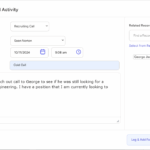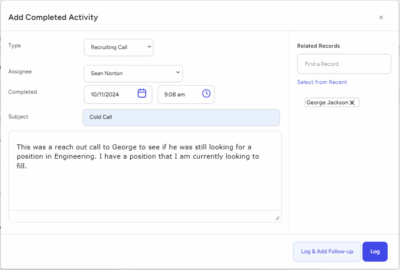In today’s digital age, recruitment has undergone a significant transformation. Gone are the days of relying solely on job boards and email to attract and engage with job seekers. Text recruiting software has emerged as a powerful tool for recruiters to reach and engage with candidates. In this blog posts, we’ll discuss text recruiting software, its benefits, and how it is changing the recruitment industry.
But, as always, a definition is in order before we get too far ahead of ourselves (which, of course, we will).
What is text recruiting software?
The question is . . . what is text recruiting software?
Text recruiting software is a tool that enables organizations to engage with potential job candidates via text messaging. This software can be used to automate and streamline the recruitment process, enabling organizations to reach a larger pool of qualified candidates in a more efficient and effective manner.
Text recruiting software can be particularly useful in industries with high turnover rates or those that require frequent recruitment, such as retail, Hospitality, or Healthcare. By leveraging text messaging, organizations can reach candidates quickly and effectively, reducing the time and resources required to fill open positions.
One of the primary benefits of text recruiting software is that it enables organizations to engage with candidates in a more personalized and convenient manner. Text messages are more likely to be read and responded to than email or phone calls, and candidates can respond to messages on their own time, without the need for scheduling phone calls or in-person interviews. This can help organizations reach a larger pool of qualified candidates and reduce the time-to-hire. Bu we’ll get to all of that in just a minute . . .
The benefits of text recruiting software
Text recruiting software can also help organizations improve many things associated with their hiring efforts. By leveraging text messaging, organizations can provide candidates with timely updates on the recruitment process, answer questions, and provide feedback on their applications. This can help to build trust and establish a positive relationship with candidates, ultimately leading to increased engagement and loyalty.
It also allows recruiters to send text messages to candidates directly from their desktop or mobile device. Text recruiting software is typically integrated with and applicant tracking system (ATS) and candidate relationship management (CRM) software to streamline the recruitment process.
Below are eight main benefits of text recruiting software:
#1—It allows recruiters to reach candidates where they are.
Text recruiting software enables recruiters to reach candidates where they are by leveraging the convenience and ubiquity of mobile devices. With over five billion mobile phone users worldwide, text messaging has become one of the most common forms of communication. By using text recruiting software, recruiters can reach candidates where they are – on their mobile devices – and engage with them in a way that is fast, efficient, and convenient.
This is particularly important because many candidates prefer to communicate through text messages rather than phone calls or emails. Text messaging is a preferred communication channel for many candidates, particularly younger generations, who are more likely to use their mobile devices for work-related communication. By using text recruiting software, recruiters can leverage this preference and engage with candidates in a way that is more familiar and comfortable for them.
Text recruiting software can also help recruiters to reach candidates who may not have been actively looking for a job but are still open to new opportunities. Many software platforms allow recruiters to proactively reach out to potential candidates who may not have otherwise applied for the role or who may not have been aware of the opportunity. By widening the talent pool, recruiters can identify candidates with unique and valuable skills, experiences, and perspectives, which can ultimately lead to better hires.
Finally, this software can help recruiters to reach candidates quickly and efficiently. Text messages have a high open rate, and candidates are more likely to respond promptly, allowing recruiters to move candidates through the hiring process more quickly. This can save time and reduce the need for additional resources to manage the recruitment process.
#2—It enables recruiters to communicate with candidates in real-time.
Real-time communication is essential in recruitment because candidates expect timely and responsive communication throughout the hiring process. By using text recruiting software, recruiters can send and receive messages instantly, allowing them to respond to candidate inquiries or provide updates on the recruitment process more quickly and efficiently.
For example, recruiters can use the software to schedule interviews or respond to candidate questions in real-time, rather than relying on email or phone calls. This can help to reduce delays and streamline the recruitment process, which can ultimately lead to better hires.
Text recruiting software can also enable recruiters to provide candidates with real-time feedback and advice. For example, recruiters can use chatbots or other automated tools to provide candidates with instant feedback on their resumes or interview performance, which can help candidates to improve their skills and increase their chances of success.
Real-time communication can also help to create a sense of urgency and excitement among candidates. By sending updates and reminders in real-time, recruiters can keep candidates engaged and motivated throughout the recruitment process. This can help to build stronger relationships with candidates and create a more positive candidate experience.
Text recruiting software can also enable recruiters to conduct real-time candidate screening and assessment. By using chatbots or other automated tools, recruiters can ask candidates to answer pre-screening questions or take assessments, which can provide real-time feedback on their qualifications and suitability for the role. This can help recruiters to identify the most qualified candidates more quickly and efficiently, which can ultimately lead to better hires.
#3—It allows recruiters to send personalized messages to candidates.
Text recruiting software enables recruiters to send personalized messages to candidates by leveraging automation, artificial intelligence, and machine learning. With the help of chatbots or other automated tools, recruiters can create personalized messages tailored to each candidate’s unique needs and preferences. By using data about a candidate’s past interactions, skills, experience, and preferences, recruiters can create highly targeted messages that are more likely to resonate with candidates and keep them engaged throughout the recruitment process.
For example, text recruiting software can analyze a candidate’s response to a job posting and identify key skills or experience that they may have mentioned. Recruiters can then use this information to craft personalized messages that highlight the candidate’s relevant skills and experience and explain how they would be a good fit for the role. This level of personalization can help to build stronger relationships with candidates and make them feel more invested in the opportunity.
Text recruiting software can also use artificial intelligence and machine learning to analyze candidate behavior and preferences and identify patterns or trends that may be indicative of their interests or priorities. This can help recruiters to create more personalized messages that are tailored to each candidate’s specific needs and preferences.
This software can also enable recruiters to send timely and relevant messages to candidates throughout the recruitment process. This can include reminders about upcoming interviews, updates on the status of their application, or other important information. By providing this level of personalized and timely communication, recruiters can help candidates to feel more engaged and informed throughout the process, which can ultimately lead to a better candidate experience.
#4—It enables recruiters to send automated messages.
Text recruiting software enables recruiters to send automated messages, which can help to save time and increase efficiency in the recruitment process. Automated messages can be created and scheduled in advance, allowing recruiters to send timely and relevant messages to candidates without having to manually send each message individually. For example, recruiters can create automated messages to confirm interview times, provide updates on the status of an application, or thank candidates for their interest in the position.
Automated messages can also be used to initiate conversations with candidates and provide them with important information about the role and the company. For example, recruiters can create automated messages to provide candidates with details about the job description, qualifications, and requirements, as well as information about the company culture and benefits.
Text recruiting software can also enable recruiters to create custom workflows that trigger automated messages based on specific actions or events. For example, recruiters can set up a workflow that automatically sends a follow-up message to candidates who have applied for a position but have not yet scheduled an interview. This can help to keep candidates engaged and move them through the recruitment process more quickly.
Automated messages can also help to improve the candidate experience by providing timely and relevant communication throughout the recruitment process. Candidates expect frequent updates and communication during the recruitment process, and automated messages can help to keep them informed and engaged.
#5—It allows recruiters to send targeted messages.
Text recruiting software also allows recruiters to segment their candidate database and send targeted messages to specific groups of candidates, which can help to increase the effectiveness of recruitment campaigns and improve the candidate experience. Segmenting the candidate database allows recruiters to group candidates based on certain characteristics or behaviors, such as job title, location, skills, or past interactions with the company. Recruiters can then send targeted messages to these groups of candidates that are tailored to their specific interests and needs.
For example, if a recruiter is looking to fill a position that requires specific skills, they can segment their candidate database to include only candidates with those skills and send them a targeted message that highlights the specific skills required for the role. This can help to attract more qualified candidates and reduce the number of unqualified candidates who apply.
Segmentation can also help to create a more personalized candidate experience. By sending targeted messages that are tailored to a candidate’s specific interests and needs, recruiters can show candidates that they are valued and that their interests are being taken into account. This can help to build stronger relationships with candidates and increase the likelihood that they will accept a job offer.
Text recruiting software can also enable recruiters to track and analyze the effectiveness of their recruitment campaigns. By using analytics tools to monitor candidate behavior and engagement, recruiters can identify which messages are most effective and adjust their recruitment strategies accordingly.
#6—It can help reduce recruitment costs.
Recruiting new employees can be a time-consuming and costly process for companies, particularly those that receive a large number of applications. Fortunately, text recruiting software can help to reduce recruitment costs by streamlining the process and improving communication with potential candidates.
Text recruiting software allows companies to communicate with candidates via text message, which is often faster and more efficient than traditional methods like email or phone calls. Text messages have a high open rate, and candidates are more likely to respond promptly, allowing recruiters to move candidates through the hiring process more quickly. This can save time and reduce the need for additional resources to manage the recruitment process.
In addition to improving communication, text recruiting software can help to automate certain tasks that would otherwise require significant time and resources. For example, software can be used to automatically screen candidates based on specific criteria, such as their qualifications or experience. This can save recruiters from having to manually review each application, which can be particularly useful when dealing with a large volume of candidates.
#7—It can help improve the quality of hires.
Text recruiting software can significantly improve the quality of hires by streamlining the recruitment process, facilitating better communication, and providing recruiters with valuable insights into candidate behavior and preferences.
One of the primary ways that text recruiting software can improve the quality of hires is by allowing recruiters to engage with candidates more efficiently and effectively. Text messaging is a highly preferred communication channel for many candidates, particularly younger generations, and it can help to establish a more personalized and meaningful connection between recruiters and candidates. By providing faster and more personalized responses, text recruiting software can help recruiters to build stronger relationships with candidates, which can ultimately lead to better hires.
The software can also help to improve the quality of hires by providing valuable insights into candidate behavior and preferences. Many text recruiting software platforms use artificial intelligence and machine learning to analyze candidate responses and identify patterns and trends that may be indicative of a candidate’s skills, experience, and fit for the role. By providing recruiters with this valuable data, they can make more informed decisions about which candidates to prioritize and how to tailor their recruiting strategies to attract the most qualified and suitable candidates.
Text recruiting software can also help to improve the quality of hires by providing recruiters with greater access to a wider pool of candidates. Many software platforms allow recruiters to reach out to candidates who may not have otherwise applied for the role or who may not have been aware of the opportunity. By widening the talent pool, recruiters can identify candidates with unique and valuable skills, experiences, and perspectives, which can ultimately lead to better hires.
#8—It can help improve the candidate experience.
Text recruiting software can significantly improve the candidate experience by providing a fast, convenient, and personalized communication channel between candidates and recruiters.
One of the primary ways that text recruiting software can improve the candidate experience is by streamlining communication. Candidates are often frustrated by slow and unresponsive recruiters, and by providing them with a fast and convenient communication channel, recruiters can improve the overall experience. As mentioned above, text messaging is a preferred communication channel for many candidates, and it allows recruiters to respond quickly and efficiently to candidate queries, keeping them engaged and informed throughout the recruitment process.
The software can also provide a more personalized experience for candidates by tailoring messages and interactions to their specific needs and preferences. By using chatbots or other automated tools, recruiters can provide candidates with customized information about the role, company, or recruitment process, helping them to feel more engaged and invested in the opportunity. This level of personalization can also help to build stronger relationships with candidates, which can ultimately lead to a more positive candidate experience.
Text recruiting software can help to reduce the stress and uncertainty that many candidates experience during the recruitment process. By providing regular updates, timely feedback, and clear instructions, candidates can feel more confident and informed throughout the process, reducing their anxiety and frustration. This can ultimately lead to a more positive candidate experience, even if they are not ultimately selected for the role.
When you “boil it all down,” text recruiting software is a powerful tool for recruiters to engage with candidates and improve the recruitment process. Its benefits include the ability to reach candidates where they are, communicate in real-time, send personalized and targeted messages, reduce recruitment costs, improve the quality of hires, and improve the candidate experience, among other things, As the recruitment industry continues to evolve, text recruiting software will become an increasingly important tool for recruiters to attract and engage with top talent.








